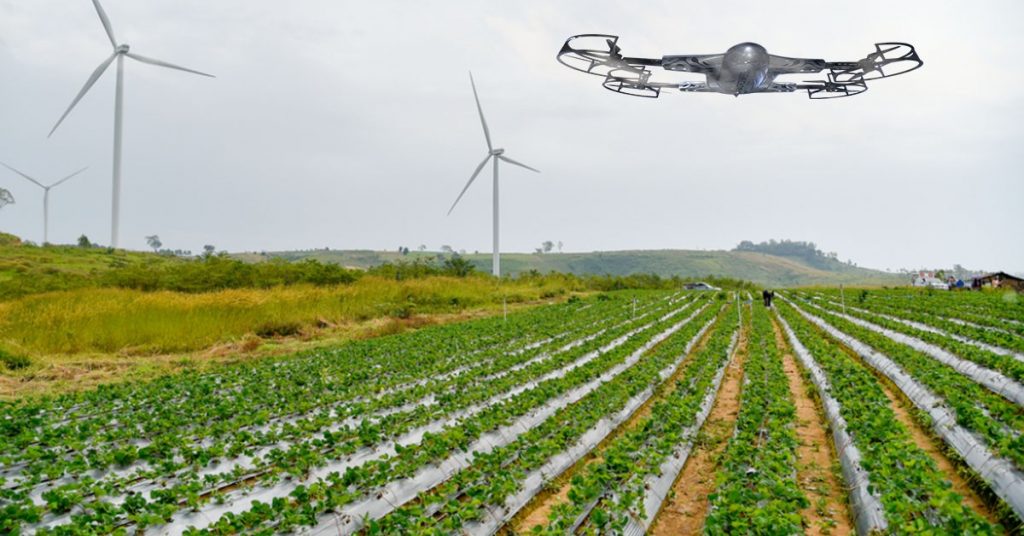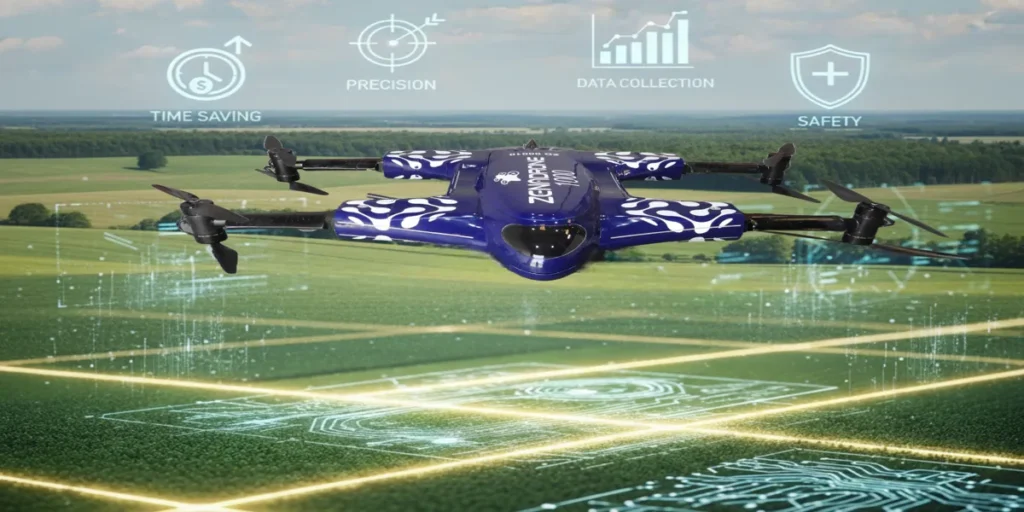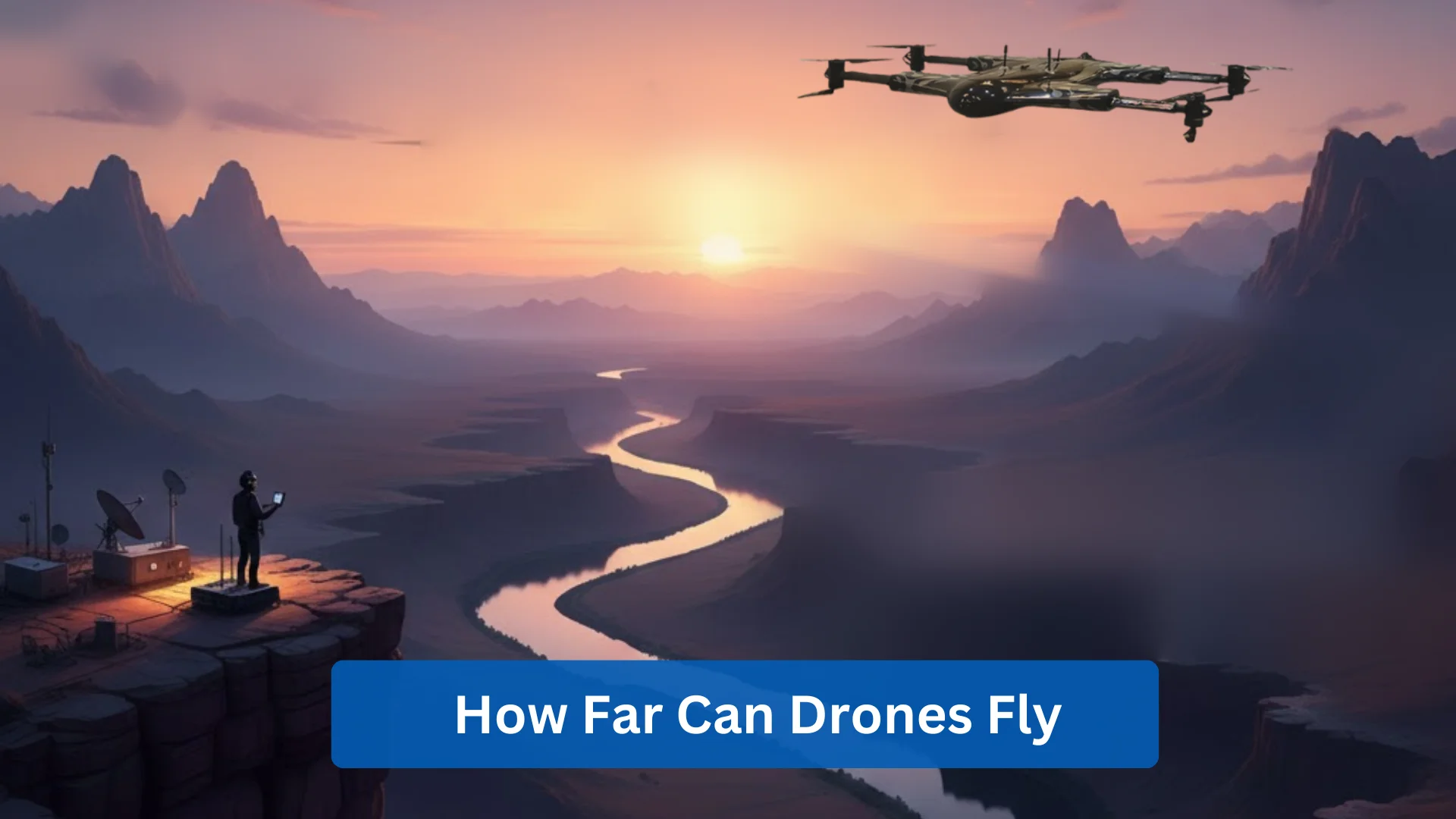The Benefits and Uses of Agricultural Drones in 2025

For a farmer, each day is a balancing act: facing the sun for hours, adapting to sudden weather changes, and making sure no part of the vast fields is left unattended. Any problem, no matter how small, left unattended can ruin a whole crop, making it hard for farms to make money. Fortunately, today’s technology offers farmers tools that help them deal with these problems more easily and effectively. Agricultural drones are revolutionizing farming. They are introducing a new era defined by precision and unmatched efficiency.
Drones provide a bird’s-eye perspective of your fields, allowing you to detect crucial issues such as pests, disease, and water stress at an early stage. This allows for swift, targeted action to protect your yield. This capability ensures that resources are applied exactly where they are needed, which is one of the key benefits of agricultural drones. Knowing which crops need nourishment without walking across each row saves time, reduces labor and chemical costs, and boosts overall returns. In the end, drone technology offers a clear path forward for agriculture, one that leads to greater productivity, higher profits, and better environmental stewardship.
Agriculture Drone Mapping
Seeing your fields from the air changes everything. Drone mapping turns guesswork into a precise management plan. In order to generate precise, geographically linked maps of your fields, this method employs high-tech cameras with features like RGB and multispectral sensors combined with precise GPS technology. Because they show details that can’t be seen from the ground, these maps are unique.
A farmer using an agriculture mapping drone can instantly identify specific areas of concern. For example, multispectral imagery highlights differences in plant reflectance, which directly correlates to plant health.
- When pests, illnesses, or a lack of nutrients don’t bother crops, they reflect light in a different way. This means that drone mapping for farming can now give us strong, valuable information.
- National Differences in Vegetation Index (NDVI): These maps show which crops are doing well (high vigor) and which ones are not (low vigor), so you may take action where it’s needed.
- Needs for irrigation: Drones find dry areas in a field by keeping an eye on how the moisture levels change. This lets them make accurate, localized watering schedules and cut down on water waste by a lot.
- Growth Tracking: By comparing drone maps across a season, farmers can keep an eye on how fast and evenly their plants are growing. This helps them make more accurate predictions about how much they will yield.
Furthermore, drone agriculture mapping software allows for the comparison of current images with historical data. This capability helps farmers understand long-term performance, revealing patterns in which parts of the field consistently produce the best or weakest yields.
When you’re deciding where to plant seeds or apply fertilizer, there’s no better guide than your own past results. With drone maps as your guide, you can apply water, fertilizer, and pesticides only to the areas that need them. This precision reduces waste, lessens your environmental footprint, and allows you to manage each part of a field individually.
Advantages and Disadvantages of Agriculture Drones
Like any other new technology, drones have both positive and negative advantages when used in farming. Farmers need to consider ver carefully the pros and cons before making a decision.
Advantages of Drones in Agriculture
The fundamental advantages of drones in agriculture stem from their speed, precision, and data collection capabilities:
Key Advantage | Description and Benefit |
Speed and Efficiency | Drones can survey hundreds of acres in a single flight, accomplishing in minutes what would take human scouts days. |
Precision Resource Management | Farmers can now spray water, seed, fertilizer, and pesticide with millimeter-level accuracy thanks to Variable Rate Technology (VRT), made possible by drones. Waste and chemical costs are cut in half as a result. |
Early Problem Detection | High-resolution thermal and multispectral cameras can detect plant stress (from pests, disease, or nutrient deficiency) days or weeks before it’s visible to the naked eye. This allows for timely intervention, preventing widespread crop loss. |
Improved Safety | Agricultural spraying drones, once employed, lessens the exposure of workers to chemicals and eliminates the need for unsafe manual inspections in difficult or dangerous terrain, among other safety benefits. |
Data-Driven Decision-Making | Optimized planting, treatment, and harvesting methods are achieved by using the large and high-quality data sets acquired (NDVI, thermal, 3D mapping) as evidence for every decision. |
The advantages of using drones in agriculture include the ability to move quickly across a field, assess plant health comprehensively, and have all necessary information at your fingertips.
Disadvantages of Agriculture Drones
Despite these advantages are fascinating, a balanced view requires acknowledging the current limitations.
Key Disadvantage | Description and Consideration |
Initial Investment Cost | High-quality, professional-grade spraying or mapping drones can be expensive, ranging from $15,000 to over $30,000. |
Operational Expertise and Training | Effective drone use requires specialized training for operators in flight safety, data processing, and software interpretation. |
Regulatory Hurdles | Certain regions may be restricted to drone operations due to regional regulations limiting flight distance, height, and line-of-sight. |
Battery Life and Range | The limited battery life, despite advancements, means that covering large fields often necessitates numerous landings and battery swaps. |
Maintenance and Upkeep | Spraying drones, in particular, require careful cleaning and regular maintenance to keep their sensors accurate and ensure they operate reliably. |
Despite these challenges, the long-term gains in efficiency, yield, and cost savings typically outweigh the initial disadvantages, making the investment worthwhile for large-scale, precision-focused farms.
Best Agricultural Drones in 2025
The market for best agricultural drones is rapidly advancing, with models offering superior battery life, sophisticated AI integration, and higher payload capacities. Selecting the best uav agriculture depends on the farm’s size and the primary task (spraying vs. mapping).
Here are some of the most trusted drones in 2025:
Drone Model | Primary Function | Tank Capacity | Key Differentiator | Ideal User |
ZenaDrone1000 | Spraying, Mapping, Monitoring | 25 Liters | Utilizes new spraying methods using AI, accurate real-time tracking of crops, and automatic obstacle recognition. | Precision-focused farms require data integration and spraying. |
DJI Agras T30 | Precision Spraying | 30 Liters | The16-nozzle design makes sure that the pressure is spread out evenly, and the frame can be folded up to save space. | Large-scale commercial farms focused on high-speed spraying coverage. |
Yamaha RMAX | Spraying & Seeding | 16 Liters | A durable drone that has been used successfully in orchards and row crops. | Farms with difficult terrain, orchards, or specialized seeding needs. |
XAG P30 | Monitoring & Spraying | 20 Liters | Modular system, combines GPS mapping and precise application into a single unit. | Farmers need a versatile platform for both scouting and treatment. |
Parrot Bluegrass Fields | Crop Scouting & Mapping | N/A | Dedicated multispectral camera (Sequoia+ sensor) for accurate plant health analysis. | Small to medium farms prioritizing detailed, scientific crop analytics over spraying. |
When it comes to agricultural spray drones, the best models combine smart technology with lasting performance. The ZenaDrone1000 excels in this, using centimeter-level GPS and AI to spread chemicals evenly, reduce environmental impact, and boost efficiency. Remember, before buying a drone, farmers should think about the area, the crops they harvest, and how much automation they’ll need.

Agriculture Drone Services
Some farms just do not have the resources to invest in the time, energy, and money required to acquire and operate drones. This gap is effectively filled by agriculture drone services, which offer farmers all the technological benefits of drones without the associated hassles of ownership. These third-party providers manage the equipment, software, and skilled personnel, delivering actionable results directly to the farmer.
Agriculture drone services typically offer a suite of specialized functions:
- The use of precise drones for aerial mapping and data collection allows for the recording of thermal and multispectral images, which aid in the analysis of crop health, soil quality, and irrigation efficiency.
- By using licensed drone operators, Precision Spraying Services ensures correct application of fertilizers, insecticides, or fungicides, all while complying with local rules.
- In the context of monitoring and analysis, data from flights is processed, interpreted by experts, and then presented in a way that is easy to understand and implement, such as fertilizer prescription maps.
- Seasonal and Local Support covers services such as soil testing before planting, disease diagnosis during the season, and yield forecasting near harvest.
Agriculture drone services pricing usually depends on factors like the size of your fields (per acre), the complexity of the service (basic RGB mapping versus multispectral analysis), and the number of flights required each year. Farmers searching for agriculture drone services near me often consider these factors to find the best value. By choosing a service model, farmers save on training, equipment maintenance, and obsolescence risk, making advanced farming accessible to operations of all sizes.
Agricultural Drone Pricing and Sales
If you’re trying to budget for a drone, the first question is always about cost. The price tag really depends on a few key things: how advanced the drone is, how much it can carry, and the quality of its sensors.
Drone Type | Price Range | Key Capabilities | Ideal Buyer |
Entry-Level/Mapping | $1,500 -$5,000 | Basic RGB mapping, small-scale crop monitoring. | Small farms, farmers new to drone technology. |
Mid-Range/Hybrid | $5,000 -$15,000 | Advanced mapping, integrated GPS, light spraying capacity. | Medium-sized operations, mixed crops. |
High-Capacity Spraying | $15,000 -$30,000+ | Large tanks (20L+), highly accurate AI spraying, obstacle avoidance. | Large commercial farms, service providers. |
The high-volume pumps, powerful motors, and complex flight controllers needed to lift huge payloads drive up the price of agricultural spraying drones; a 20-liter model, for instance, can cost anywhere from $18,000 to $25,000.
Used Agricultural Drones for Sale
An increasingly popular option for farmers is purchasing used agricultural drones for sale. These models, which are often just a season or two old, offer reliable modern technology at a cost that is significantly less.
New vs. Pre-Owned Drones: Pros, Cons, and Best Use
Option | Pros | Cons | Best for |
New Drone | Latest AI features, full warranty, high reliability | Higher upfront cost | Farmers seeking long-term investment |
Used Drone | Lower cost, faster acquisition | Shorter lifespan, limited warranty | Farmers testing drone technology or managing tight budgets |
Whether you buy new or used, the key question is simple: will the drone save you more on labor and chemicals than it costs? That’s how you get a fast return on your investment.
Location-Based Agriculture Drone Services
A good drone service needs to know your farm. They should understand your crops, your weather, and your local rules. This local knowledge helps them get to you faster and understand your field data better. A one-size-fits-all approach doesn’t work in farming.
State | Key Drone Services | Notes |
Alabama | Spraying, mapping, crop monitoring | Precision spraying reduces chemical use |
California | Drone services, mapping, soil analysis, spraying | Supports vineyards and row crops |
Florida | Monitoring, spraying, disease detection | Citrus farms benefit from yield prediction |
New Jersey | Drone spraying, mapping, monitoring | Supports orchards and vegetables |
New York | Mapping, monitoring, spraying | Optimizes fertilizer and pesticide use |
North Carolina | Mapping, monitoring, spraying | Improves resource efficiency |
Local providers can help with training, seasonal assistance, and individualized drone flights. Quicker responses and more accurate results when searching for drone services near me are guaranteed by location-specific knowledge.
Conclusion
Agricultural drones, which transform operations by decreasing waste and boosting precision, are the future of sustainable and effective farming. From creating hyper-accurate field maps and detecting early signs of disease to performing highly targeted spraying, drones save time, cut costs, and ensure higher, more predictable yields.
The strategic application of drone technology is the clearest path for modern farms to boost profitability and adhere to environmental best practices. ZenaDrone is at the forefront of this revolution, specializing in advanced ZenaDrone agriculture drone services, including innovative drone fruit farming solutions. Their flagship AI-powered drone, the ZenaDrone1000, offers superior advantages in precision and data analysis, providing farmers with a competitive edge.
While the initial prices for high-capacity drones can be a disadvantage, ZenaDrone’s service model makes the technology accessible to all. Their platform uses proprietary AI technology to instantly analyze crop images, turning raw data into actionable treatment maps, a significant improvement over standard systems. With ZenaDrone, you get all the benefits of precision farming without the hassle. We take care of the equipment maintenance and operator training, letting you focus on what you do best. Are you prepared to level up the sustainability and production of your farm? Get in touch with ZenaDrone now to find out how their cutting-edge drone services can improve the efficiency and intelligence of your upcoming crop. With Zenadrone, farming the future starts with a single flight!
Contact Us
Thank you for your message. It has been sent.
Latest Posts
Social Profiles















